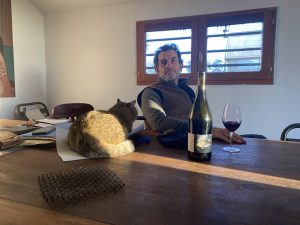Château la Franchaie
Eric Dubois

It’s impossible to dissociate Eric Dubois from viticulture and winemaking, as he so effortlessly embodies the craft. At Château la Franchaie, he directs his work with a subtle, knowing hand and a healthy share of playfulness. The emerging wines are all vibrant expressions of the angevin (Anjou) terroir, and its manifold possibilities.
Until 2016, Eric had been in charge of the Clos Cristal for 21 years. This historic parcel is the legacy of local winemaking hero Antoine Cristal, donated in 1890 to the Hospices de Saumur. Imbued with this experience, Eric and his partner Alex decided to go out and acquire their own vines. Concerned only with their work ethic and convictions, they had no specific destination, and traveled all the way to Italy and Portugal looking for the right parcel. During these travels, they confronted the various difficulties brought on by the changing climate, and came to the realization that the Loire Valley might after all still be where they wanted to start this new adventure.
There were only really two conditions. For starters, the family’s three horses needed to have open spaces and prairies that they could comfortably dwell in. Second, the vineyard would under no circumstances be surrounded only by other vineyards. During the search, Eric honed his skills and deepened his knowledge while working at La Coulée de Serrant with Nicolas Joly.
Eric then acquired the domaine’s first 5.5 hectares of vines when Loïc Mahé, a local vigneron in Savennières, preferred to focus his efforts on fewer parcels. It was exactly what Eric needed: the vine plantings were located next to pastures, along with oak trees and cereal crops. Not only did the biodiversity bring more life to the land, but the distance from other vineyards acts as a buffer, protecting from the spread of diseases that target or thrive on vines. The first harvest at Château la Franchaie officially took place in 2018.
From their house on the land, one can look into the valley and trace the way the Loire has carved its path into the hills. The topsoil is of alluvial sand and silts deposited by the river that only goes 30 cm deep. It rests on a subsoil of schists, which compounds the soil's draining quality. Hydric stress is the perpetual, and therefore a key variable for Eric, as he works according to the conditions of each year to find ways—whether in the vines or in the cellar—to avoid that stress carrying over into the finished wines.
The cellar is populated with various tanks, barrels, amphoras, drums, and dame-jeannes. Work here is methodical and unhurried. Grapes are destemmed by hand, and pumpovers, punchdowns, and stirring are never practiced. Marrying technique with a fondness for curious objects, Eric acquired tanks that were initially designed to contain eggs for the biscuit industry, as well as some spherical stainless steel tanks the original purpose of which was to transport milk for long distances without churning it. The latter is specifically suited for the maceration period of his reds, as it offers a gentle natural convection.
What keeps Eric going is his winemaker’s calling to see things through from their inception to their realization, as well as to understand and grasp the workings of vines, flora, insects, soils, juices, and fermentations, all the way through to the service and enjoyment of wine. This inspiration is infectious, and grows with each encounter and opened bottle.



